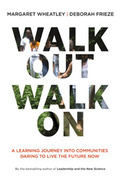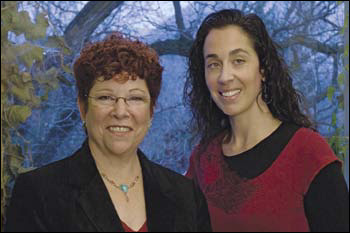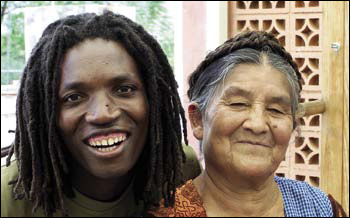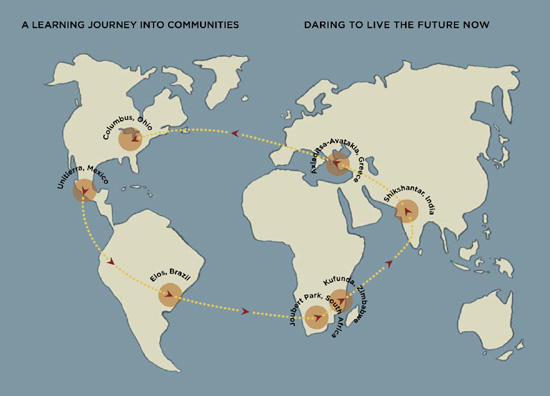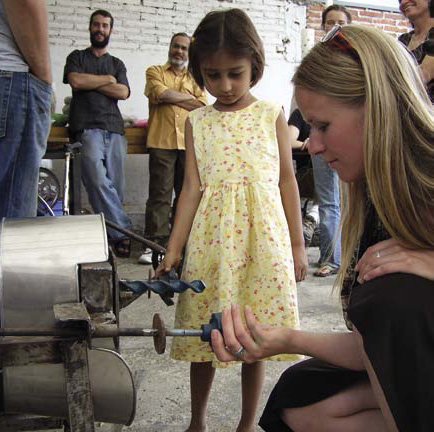
Download PDF Excerpt
Videos by Coauthors
Follow us on YouTube
Rights Information
Walk Out Walk On
A Learning Journey into Communities Daring to Live the Future Now
Margaret Wheatley (Author) | Deborah Frieze (Author)
Publication date: 04/11/2011
Bestseller over 20,000+ copies sold
Find out more about our Bulk Buyer Program
- 10-49: 20% discount
- 50-99: 35% discount
- 100-999: 38% discount
- 1000-1999: 40% discount
- 2000+ Contact Leslie Davis ( [email protected] )
Approaching 80, I look back and see what a rich and blessed life I’ve had. I’ve been able to give my curiosity free rein and to be with extraordinary teachers and companions. I’ve been able to explore a wide range of disciplines, lived in several different cultures, and raised a large family.
I’ve learned from an incredible diversity of people, from Indigenous peoples to the Dalai Lama, from small town ministers to senior government ministers, from leading scientists to National Park rangers, from engaged activists to solitary monastics. This access to so many sources of experience and wisdom, held in the container of friendship, continues to deepen my resolve to bring whatever I’m learning into my books and teachings.
I had an excellent liberal arts education at the University of Rochester and University College London. I served in the Peace Corps in Korea, 1966–1968, learning to thrive in a post-war, traditional culture where everything was different, teaching junior and senior high school English (minimum class size was 65). My M.A. is from New York University in Media Ecology with Neil Postman. My doctorate is from Harvard’s program in Administration, Planning, and Social Policy, focused on organizational behavior and change.
I have been a consultant and speaker since 1973, working with all types of organizations and peoples, on all continents (except Antarctica). Working in so many different places, it’s been easy to recognize patterns of behavior common across cultural and institutional differences, and to also note behaviors and worldviews specific to different cultures. It also has kept me alert to changing trends in leadership.
I was full-time faculty in two graduate management programs, Cambridge College, Cambridge, Massachusetts, and The Marriott School of Management, Brigham Young University, Provo, Utah. I’ve been a formal adviser for leadership programs in England, Croatia, Denmark, Australia, the United States and, in Berkana, with leadership initiatives in India, Senegal, Zimbabwe, South Africa, Mexico, Brazil, Greece, Canada, and Europe. I was a formal adviser to the Director of the National Park System for ten years, a highlight in my career.
I am co-founder and president of The Berkana Institute, a global nonprofit founded in 1991. I am very proud of our decades of experimentation and support of life-affirming leaders everywhere. Explore our rich and varied history at www.berkana.org
My most creative work is The Warrior’s Songline, A Journey Guided by Voice and Sound (2020). This is a collaboration with Jerry Granelli. Jerry and I began training Warriors for the Human Spirit in 2015. He was a famous jazz drummer and composer as well as superb teacher of warriorship--he died in 2021, and the Songline is our legacy work. This is a new form melding voice and sound to create an evocative and transcendent experience introducing listeners to the Warrior’s Path. https://margaretwheatley.com/the-warriors-songline/
I’ve published twelve books and written dozens of articles (free on my website). My writings have been an invitation to explore new ways of leading based on wisdom drawn from new science, history, archeology, cosmology, and many spiritual traditions. I’ve sought to apply this rich and crucial wisdom to the challenges of leadership and how people can live well together as community, no matter what’s happening in external circumstances.
I was raised in New York City area and then lived in the Boston area. Since 1989, I’ve lived happily in Utah. I have two adult sons and five stepchildren, all seven from the same father. I have dozens of grandchildren and greatgrandchildren, most of whom live in Utah. I am held by the guardian mountains of Utah and frequently seek ground in red rock canyons just a few hours away. My peaceful mountain home supports me to do my work and to take frequent brief spiritual retreats. My spiritual teachers’ guidance keeps deepening my spiritual practice, and I delight in the close proximity of beloved family.
To keep current with my work, https://margaretwheatley.com/library/current-thinking/
PART I
LEAVING HOME
This is the setting out.
The leaving of everything behind.
Leaving the social milieu. The preconceptions.
The definitions. The language.
The narrowed field of vision. The expectations.
No longer expecting relationships, memories, words,
or letters to mean what they used to mean.
To be, in a word: Open.
—Rabbi Lawrence Kushner
This book takes you on a Learning Journey to places that will inspire, disturb, and provoke you, and to meet people who will delight, nourish, and encourage you. We’re glad that you’ve joined us. We visit seven communities around the world, seven very different cultures, all of which are experimenting with what it means to live the future now. We, the authors, are intimately connected with each of these communities; we’ve worked alongside them for several years and been transformed by these experiences and relationships.
Our journey takes us to Mexico, Brazil, South Africa, Zimbabwe, India, Greece, and the United States. In each community, we’ll experience firsthand what’s possible when we change our beliefs about what people are capable of and how change happens. We’ll witness communities that rely on everyone to be an entrepreneur, a leader, an artist. These communities trust that these are common human traits, not limited to a few gifted people. We’ll meet people who use their ingenuity and caring to figure out how to work with what they have to create what they need.
And as we move from community to community, we’ll explore the deeper patterns that link them together, diverse as they are. We’ll see how change happens through self-organized efforts that then move across the planet through networks of relationship. We’ll see that lasting change doesn’t start from the top of a system, but from deep inside it, when people step forward to solve a problem, then move on to the next issue that needs addressing. We’ll see how much becomes possible when we abandon hope of being saved by the perfect leader or the perfect program, and instead look inside our community to notice that the resources and wisdom we need are already here.
In every community, you’ll meet the Walk Outs Who Walk On. Perhaps you’ll recognize yourself in some of them.
WALK OUTS WHO WALK ON
Walk Outs are people who bravely choose to leave behind situations, jobs, relationships, and ideas that restrict and confine them, anything that inhibits them. They walk on to the ideas, people, and practices that enable them to explore and discover new gifts, new possibilities.
We learned the phrase “Walks Outs Who Walk On” from our friends in India. They had created a network of young people who chose to leave school. They didn’t consider themselves “dropouts,” a negative label assigned to them by the school system. They left school because they wanted to be learners, not passive students. They walked on to discover many ways they could contribute to creating change in their world. 1
Although the phrase may be new to you, think about situations in your life that you’ve consciously chosen to leave because you knew that to stay any longer would limit you. Whenever we choose to leave behind what confines us, whenever we courageously step forward to discover new capacities, then we can rightfully call ourselves Walk Outs Who Walk On.
The people you meet on this journey have walked out of a world of unsolvable problems, scarce resources, limiting beliefs, and destructive individualism. They’ve walked on to beliefs and practices that solve problems and reveal abundant resources. They’ve created communities where everyone is welcome to learn, grow, and contribute. They’ve walked out of the greed and grasping of this time, where many individuals try to get as much as they can, and walked on to discover how to create what they need with what they have. And while we visit only seven communities on this journey, there are millions more people like them throughout the world.
When people and communities walk out, they discover they’re more gifted and wiser than they believed or had been told, that working together—even in the harshest circumstances—can be joyful, that they can invent solutions to problems that others have declared unsolvable. These communities are creating meaningful change in some of the most difficult political, social, and economic circumstances. They may have little money, few trustworthy formal leaders, and minimal material resources. They may have been told they’re “backward” or don’t possess the requisite expertise to solve their own problems. Had they accepted current thinking, they would have sat back and waited passively for help to come from the outside—from experts, foreign aid, heroic leaders.
But instead, they walked out. They had the good sense not to buy into these paralyzing beliefs about themselves and how change happens. They walked on to discover that the wisdom and wealth they need resides in themselves—in everyday people, their cultural traditions and their environment. They’ve used this wisdom and wealth to conduct bold experiments in how to create healthy and resilient communities where all people matter, all people can contribute. Their creativity and hard work make it easier for us to see that a different world is possible.
WHY WE VISIT THESE COMMUNITIES
Margaret (Meg) and Deborah, as your hosts for this Learning Journey, are taking you to meet people and communities we’ve partnered with for several years through our work with The Berkana Institute. 2 There are many, many other places worthy of visiting, but these are the ones we know well, that we’re most intimate with. We’re taking you to meet our friends, people with whom we’ve worked, danced, argued, cried, laughed, consoled, celebrated, and loved. Together, we’ve explored how self-organization and change happen, we’ve learned to trust the illimitable power of community, and we’ve come to realize how important our heritage and cultural traditions are.
Not only do we know these people as friends, but they also know each other well. For several years now, they’ve worked and learned together, visited one another’s communities, shared their discoveries and dilemmas, and gathered annually as a learning community. As we visit each community, you may notice how they weave through each other’s lives, how they support each other in deep friendship.
Your experience with these people and communities doesn’t have to end with this book. We’ve created www.walkoutwalkon.net where you can watch videos, hear interviews, and keep informed about where these communities and people are now. Learn more about the Walk Out Walk On website on p. 260.)
YOUR HOSTS (THE AUTHORS)
Deborah has partnered with each one of these communities since 2004. She’s led Learning Journeys to Mexico, Brazil, South Africa, and Zimbabwe. In this book, she’s written each of the seven visits, wanting you to experience what it feels like to be there, getting to know these communities and their pioneering work. All of these relationships were developed through the Berkana Exchange (an initiative of The Berkana Institute), a community of friends and a community of practice that has worked together over several years and that continues to actively engage and support one another. The people Deborah writes about have become her extended family, an intimate learning community that is inventing new solutions to the issues she cares about most—such as food security, ecological sustainability, and economic self-reliance.
Meg Wheatley and Deborah Frieze
Meg has worked with most of the people you’ll meet, in gatherings and Berkana-hosted events around the world. She’s been on the ground in the communities in South Africa, Zimbabwe, and the United States and led three Learning Journeys to South Africa and Zimbabwe. From her experiences with these communities—as mentor, student, steward, friend—she’s learned firsthand about the power of community and self-organization. (It is these people and communities who’ve informed her work over the past several years; their stories and examples appear in her articles and books.) Meg’s contribution here is to prepare you for the journey and to guide the reflections that, hopefully, lead you to think more deeply about your experiences and what might be changing in you as a result. Throughout the visits, both Deborah and Meg make visible the patterns and beliefs that connect these diverse communities.
SEVEN HEALTHY AND RESILIENT COMMUNITIES
We define these places as healthy and resilient communities because they have learned to trust themselves to find their own solutions and take control of their own future. They develop greater capacities and become smarter over time as they learn what works and how to work together. They become confident that they can deal with whatever problem confronts them next. In the face of hunger, poverty, ill health, environmental degradation, and economic injustice, they respond, adapt, invent. That’s what makes them healthy and resilient.
Healthy and resilient communities take on big issues, those that all communities eventually must deal with—food, economics, education, leadership, environmental challenges. To give you a taste of what’s ahead on this journey, here’s a brief description of where we’re going and the focus for each visit:
Mexico: From Scaling Up to Scaling Across. Taking things to scale doesn’t happen vertically through one-size-fits-all replication strategies. We’ll visit Unitierra, a new form of university, and the Zapatistas, a populist movement for self-determination. In both places, there’s a deep, unshakable belief in the power of people to claim their right to live and learn as they see fit. We’ll observe how their experiments move horizontally, scaling across villages and nations, trans-locally, as many diverse people learn from their discoveries and are inspired to try their own.
Brazil: From Power to Play. Most leaders believe that it’s their job to motivate people, that without their directive control, no work gets done. The most common way to motivate people is through external means, using punishment and reward. We’ll experience Warriors Without Weapons, where play, not power, evokes people’s passion, creativity, and motivation to work hard on seemingly overwhelming challenges.
South Africa: From Problem to Place. Today’s approach to social change posits that large and complex issues must be addressed one by one, with institutions and experts who specialize in that particular problem. We’ll explore tiny Joubert Park in Johannesburg, where people have created changes in education, public safety, arts, ecology, food, and more using the principle of start anywhere, follow it everywhere. 3
Zimbabwe: From Efficiency to Resilience. Conventional attempts to solve problems of scarcity focus on efficiencies—attempting to do more with less by cutting budgets and staff, minimizing resources, optimizing outputs. Kufunda Learning Village has achieved resilience in a time of total systems collapse by choosing a different approach. They engage in a wide range of small local actions that give them the capacity to continuously adapt to an unpredictable and chaotic world.
India: From Transacting to Gifting. The transactional culture of today promotes self-interest and scarcity; people strive to take as much as they can and accumulate more than they need. In a gift culture—common in many traditional societies—generosity prevails and money loses its power. Shikshantar is experimenting with gift culture, replacing mindless growth with the confidence that we have what we need.
Greece: From Intervention to Friendship. In our pursuit to find what works, we seldom notice how disempowering it is when we look for answers from experts and best practices created elsewhere. At the Art of Learning Centering at Axladtisa-Avatakia, participants walked out of dependence on experts and learned to trust the capacities and creativity available in friendship to address their community’s needs.
United States: From Hero to Host. When a community stops waiting for a hero to save it, it discovers internal resources and solutions to solve otherwise intractable problems. People in Columbus, Ohio, are walking out of heroic leadership and walking on to a new “operating system” of using conversational processes to address complex problems, such as health care, homelessness, poverty, public safety, and more.
These seven communities are very different from one another—different cultures, histories, and environments. But beneath these interesting and important differences, they share a common identity as Walk Outs Who Walked On.
THE ROLE WALK OUTS PLAY IN CREATING CHANGE
Walk Outs Who Walk On play a crucial role in societal change. They use this time of dissolution and failing systems to create and experiment with new ways of working and organizing. In doing their pioneering work, they rely on the fact that people’s capacity to self-organize is the most powerful change process there is. They’ve seen how local efforts can emerge into larger, transformative changes when they connect with other local efforts. They’ve confirmed Margaret Mead’s brilliant statement that the world changes by dint of small groups of dedicated people. And they’ve demonstrated that when people know where they come from—their traditions and culture—they develop strength and stamina. These pathfinders have come to understand that living is a synonym for learning: they experiment, take risks, fail, succeed, make it up as they go along, and offer compassion and forgiveness to each other.
When any of us experiment with walking on, we’re able to discover potential that we couldn’t see before we freed ourselves from constraints. It’s motivating to discover these hidden capacities and see how they serve us to accomplish good work. It’s essential that we feel motivated, that we have faith that we’re doing the right work, because whenever we use ideas and approaches that don’t conform to the world’s expectations, we’re going to meet with resistance.
At Berkana, we use a map (co-created with our global family of friends and colleagues) to describe the predictable dynamics that are bound to occur between those pioneering the new and those preserving the old. We’ve used it for many years in diverse organizations and communities and now rely on it to know what to expect when we decide to walk out and walk on.
All systems go through life cycles. There’s progress, setbacks, seasons. When a new effort begins, it feels like spring. People are excited by new possibilities, innovations and ideas abound, problems get solved, people feel inspired and motivated to contribute. It all works very well, for a time.
And then, especially if there’s growth and success, things can start to go downhill. Leaders lose trust in people’s ability to self-organize and feel the need to take control, to standardize everything, to issue policies, regulations, and laws. Self-organization gets replaced by over-organization; compliance becomes more important than creativity. Means and ends get reversed, and people struggle to uphold the system rather than having the system support them. These large, lumbering bureaucracies—think about education, health care, government, business—no longer have the capacity to create solutions to the very problems they were created to solve.
When a system reaches this stage of impotence, when it becomes the problem rather than the solution, we as individuals and communities have a choice. Either we struggle to fix and repair the current system, or we create new alternatives. New alternatives can be created either inside or outside the failing system. But if we choose to walk out and walk on, there are two competing roles we’re called upon to play: We have to be thoughtful and compassionate in attending to what’s dying—we have to be good hospice workers. And we have to be experimenters, pioneers, edge-walkers. Playing these dual roles is never easy, of course, but even so, there are enough people brave enough to do so.
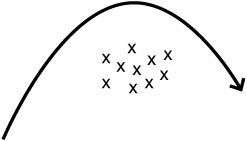
As old systems fail, a few people walk out. They walk on to experiment with new ways of thinking and organizing that enable them to find solutions to seemingly unsolvable problems. At first, they feel isolated and alone, limited in what they can achieve. They often don’t realize there are other Walk Outs.
Skilled hospice workers offer comfort and support to those at the end of their lives far beyond attending to physical needs. They help the dying focus on the transition ahead, and encourage them to see what their life has taught them—what wisdom and values shine clearly now that the distractions are gone.
Walk Outs need to do this kind of hospice work on ourselves. Even as we stop struggling to fix things, even as we reject the status quo, we don’t leap empty-handed into the future. We need to consciously carry with us the values and practices that feel essential. What have we learned, what do we treasure as the means to create good work, fulfilling lives, meaningful relationships? From our many experiences—the battles, victories, disappointments, successes—we need to glean our hard-won wisdom and preserve it at all costs. This is what we’ll most need as we walk out and walk on to give birth to the future.
Inside dying systems, Walk Outs Who Walk On are those few leaders who refuse to work from the dominant values that permeate the bureaucracy, such things as speed, greed, fear, and aggression. They use their formal leadership to champion values and practices that respect people, that rely on people’s inherent motivation, creativity, and caring to get quality work done. These leaders consciously create oases or protected areas within the bureaucracy where people can still contribute, protected from the disabling demands of the old system. These leaders are treasures. They’re dedicated, thoughtful revolutionaries who work hard to give birth to the new in very difficult circumstances.
And then there are those who leave the system entirely, eager to be free of all constraints to experiment with the future. You’ll read their stories in the next pages. But even though they might appear to have more freedom than those still inside, they encounter many challenges that restrict their actions. Old habits and ways of thinking constantly rear up on their path. It’s easy to get yanked backward, or to doubt that this is the right direction. It takes vigilance to notice when these old ways of thinking block the path ahead.
Pioneers have to expect to feel ignored, invisible, and lonely a good portion of the time. What they’re doing is so new and different that others can’t see their work even when it’s staring them in the face. These are difficult dynamics to live with, especially when you know you’ve done good work, that you’ve solved problems that others are still struggling with. This is why it’s so important that pioneers work as community, encouraging one another through the trials and risks natural to those giving birth to the new in the midst of the breakdown of the old.
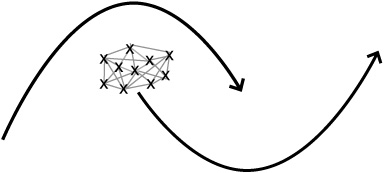
Walk Ons find each other and connect. Together, they learn quickly, take greater risks, and support one another to continue their pioneering work. A new system is born from their efforts.
If you’ve walked out of confining situations, you’ve probably experienced at least some of these dynamics. They’re easily observable in the lives of innovators and courageous leaders everywhere. They’ll be quite noticeable in the stories you’re about to read as we journey through these seven communities. In each visit, we’ll see how these difficult dynamics lose their power as we work together in community. It’s so much easier to keep walking on when we’re in the company of kindred spirits.
Before we move on to Mexico, we’d like to talk about packing. How can you travel light but ensure that you have all the essentials for a rich learning experience?
PREPARING TO LEAVE HOME
A Learning Journey can be judged successful by how much it destabilizes and challenges our worldview. If we take the risk to step into a world very different from our own, we discover that our particular way of seeing is incomplete, that there are many more ways to see and interpret what’s going on in life. We can discover that judgments and assumptions often limit our ability to see new possibilities.
Most traditions and cultures have initiation rituals that require setting out in order to be transformed. We willingly and bravely undertake a quest. We leave the comforts and safety of home, travel to strange and unfamiliar lands, and are welcomed to return only after we’ve discovered answers to our quest that we’re prepared to put into practice.
This Learning Journey in book form might not seem to be asking that much of you. You’re probably reading this in familiar surroundings. But don’t be fooled. You won’t be tested by the demons and dragons of old, but you might well be confronted by your beliefs and assumptions, internal demons that may rear up to block your path, or warn you to turn back, preventing you from reaching lands of new possibility.
THE COURAGE TO QUEST
Quests begin with a yearning that won’t let us go. These questions of profound longing can be deceptively simple: “Why can’t people be more kind?” “Why can’t we work together better?” “Why are so many people unhappy?” “Does life have to be so hard?”
Behind these questions—perhaps the reason we’re brave enough to ask them—is a deep intuition that things could be better, that life doesn’t have to be this way. This sense that more is possible can propel us beyond the safety of our daily routines, the security of our habitual ways of thinking, and send us out into the world to find answers.
Leaving home takes courage. We have to be brave enough to explore our questions, to cultivate our dissatisfaction with the present state of things, to notice what disturbs us, what feels unfair, terrible, heartbreaking. We have to be unafraid to look reality in the eye and notice what’s really going on. If what we see opens our hearts, this is a good thing, because that’s where our courage is found. With open hearts, we can bravely begin searching. We can go into the world with our questions, carried by our yearning to find a simpler and more effective way to live life and to benefit more people.
Here are a few questions that we offer to engage you as a learner. They’re designed to help you notice what you notice in your world. Among all possible information and situations, we only observe a miniscule percentage of what’s happening. As you notice what gets your attention, you can also see your filters.
What issues consistently get your attention? Which ones make you angry? Which ones make you excited?
Have you glimpsed or experienced a future that inspires and motivates you?
Who do you want to be for this world? What is the contribution you hope to make?
Are you willing to risk being changed by this journey?
PACKING FOR THE JOURNEY
As with any journey, it’s better to pack light. For this particular trip, since you’re sitting someplace comfortable, the only baggage you need to attend to is what you’re carrying in your mind. By this stage in our lives, we each have a well-developed lens for viewing the world. We began constructing this lens as young children from the beliefs and assumptions taught by our families and culture. Throughout most of our lives, we polish and refine this lens with our experiences—the good, the bad, the ugly, the sublime.
As we rush about our lives, preoccupied with tasks and responsibilities, it becomes easy to forget that how we see the world is just one of many possible interpretations. We settle into our opinions and judgments, and assume that everyone else sees things the same way. But if this were true, we wouldn’t get into arguments or difficulties with our partners, colleagues, leaders.
When we enter a new culture, we can expect to feel surprised, confused, disrupted. These are promising feelings, because they offer us a choice. Either we can retreat to the safety of our familiar opinions, or we can become curious. If we’re willing to be disturbed, we can try to let go of our judgments and confess that we don’t understand what we’re seeing.
Confusing moments are wonderful opportunities to observe our minds more closely. If something’s provoked or startled me, it’s because I assumed something different was true. I thought things worked like this, but now I’m not so sure. …
• I thought material well-being made people happy, yet I’m sitting with people who have no material goods and we’re feeling very happy, just because we’re together, sharing stories.
• I expected that good community leaders had to be formally trained and developed, yet here I am meeting dozens of people, some with no education, who are bright and capable leaders, skilled at engaging others and getting work done.
• I believed that social entrepreneurs were a rare breed of people, yet here everyone I meet seems to have ideas and is thinking about the next project or dream.
• I assumed that our methods of planning, budgeting, and strategizing were necessary to get anything done, yet here I’m meeting highly motivated people who are accomplishing great work without doing any of those activities.
As we journey together, we encourage you to welcome those moments when you feel confronted, surprised. Each one is an opportunity to see your own mind, to notice your beliefs and assumptions. And to be open to change.
Now let’s begin.







